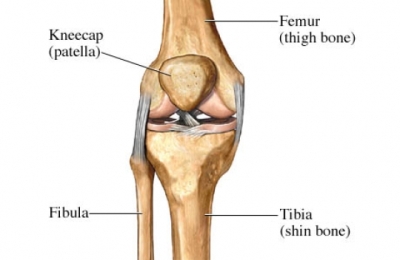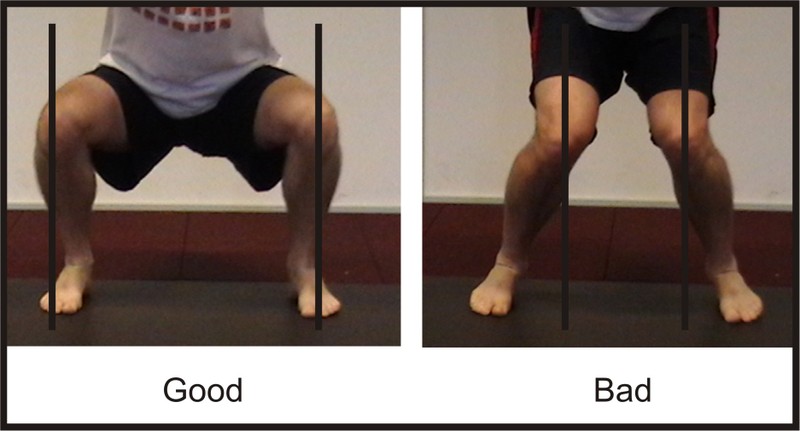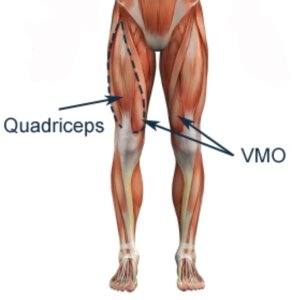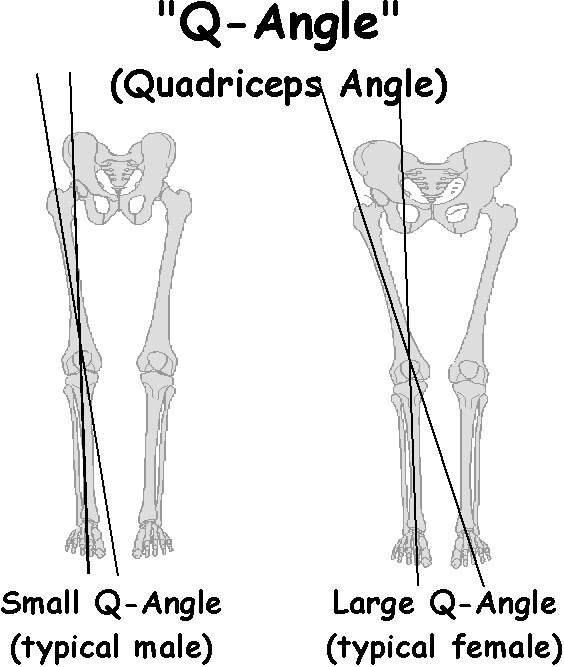To keep healthy knees, you need:
- Mobile joints above and below the knee
- A strong knee joint
- Proper mechanics during physical movement
That about sums it up.
What is the knee?
The femur, tibia, and patella come together to form the knee joint. The width of the knee joint allows the structure to handle greater loads.

The patella is your “kneecap” and sits within the quadriceps tendon, providing an enhanced mechanical advantage when the quads are contracted. The back side of the patella is a smooth surface made up of hyaline cartilage. This is important during knee movements: flexion, extension, and rotation.
The knee ligaments, capsule and menisci help to keep your knee joint together.
The value of exercise
Our bodies respond to the stresses that we place on them. If you exercise regularly, you inspire turnover and growth of knee structures (muscles and connective tissue). This is a good thing. To keep the knee joint healthy, you need to balance exercise loading, frequency, activity type, and rest/recovery.
| Loading | Frequency | Activity type & variety | Rest & recovery | Result |
| Too intense | Too often; irregular | Not enough variation | Not enough | Overuse injuries, inflammation, injury |
| Just right | Regular and consistent | Varied; well-balanced | Adequate; active recovery | Healthy knees |
| Too low | Rare; irregular | Minimal activity | Too much | Weak, injury-prone ligaments |
For instance, if you keep pounding out the hard miles doing only distance running every day, you’ll probably end up with tendonitis. On the other hand, if you sit around all day, you’ll also risk knee injury from weakened knee structures and the pressure of the kneecap on the thighbone in the seated position (aka “movie theatre knee”).
For healthy knees, get regular daily activity, keep the joint moving through a full range of motion, and do different things.
Knee ligament anatomy
Knee Ligament Anatomy Animation
Four main ligaments provide stability and prevent excessive movement of the knee.
- Anterior cruciate ligament (ACL) – prevents the tibia from moving forward
- Posterior cruciate ligament (PCL) – prevents the tibia from moving backward
- Medial collateral ligament (MCL) – prevents excessive inward movement of the knee joint. This is the most commonly injured knee ligament, but it can usually heal without surgical intervention.
- Lateral collateral ligament (LCL) – prevents excessive outward movement of the knee joint
Knee ligaments are tiny. The ACL and PCL are only 6-14 millimeters wide.
Two crescent- shaped rings of cartilage comprise the menisci. The menisci provide knee stability, distribute weight from the femur to the tibia, act as shock absorbers, and spread synovial fluid. Just like other types of cartilage, they can be torn.

It’s not just ligaments that keep our knee intact. The quadriceps, hamstrings and calves enhance stability too. When these muscles are strong, we are able to rely less on the passive structures, like ligaments, to resist unwanted movement.
What you should know about the knee
Most knee problems develop over time, not just on a random day in your basement during a dance-a-thon. This is repetitive trauma (think: wear and tear), and any mechanical device (including the knee) will fail with excessive strain. One in three sports-related injuries occurs at the knee.
Warming up and dynamic joint mobility
Warming up and dynamic joint mobility seem to be important for knee health. These practices help to control inflammation, distribute joint fluid, develop structures around the joint, and enhance range of motion.
Resistance training
Resistance training through a full (and mechanically correct) range of motion is essential for healthy knees. Weight-bearing exercises can help to promote joint stability and strength.
However, poor technique (including going too heavy in a partial range of motion) and too-heavy or too-frequent resistance training without adequate recovery can damage the knee joint. Don’t keep hammering away at those squat one-rep-maxes too often — mix up the movements and the loading.
And remember that your legs move in more than one plane! Try asymmetrical and one-legged movements such as:
- “star” lunges or jumps (stepping/jumping out to the side or on a diagonal)
- stagger-stance squats, wrestling shoots
- side/diagonal step-ups on to platforms
- zig-zag jumps and runs, etc.
Common knee problems
Patellar tendonitis
Get ready for this knowledge bomb: Tendonitis is the inflammation of a tendon. Who knew? This often takes place with repeated stress and loading (translation: overuse). Ice, adequate recovery between workouts, and developing mobility can help. You can reduce discomfort by limiting the range of motion during exercises, but ideally you want to work your way back to a full, healthy range. You can also use static holds and eccentric training.
Chondromalacia patella/kneecap pain
You’ll often notice this with climbing stairs, walking down hills, or sitting. This is the progressive destruction of hyaline cartilage on the backside of the kneecap. You might hear snapping, popping and cracking noises when you bend your knee. Perfect technique on lower body exercises and reducing the range of motion (with the eventual aim of increasing that ROM) can help. Women tend to suffer from this condition more than men.
Torn meniscus/removal of meniscus
Meniscus problems often manifest as a catching or grinding sensation in the knee. Since a meniscal injury can cause pain, catching and swelling, many people opt for surgery to remove torn bits. Menisci lack blood supply except at their outer rim, so they often heal poorly when torn. Heavy vertical compressive loads (e.g. heavy squatting, jumping) can interfere with healing. Use a limited, gradually increasing range of motion and minimal resistance while recovering.
Ligament problems
ACL injuries are common in sports with running and jumping, such as basketball and soccer, or with twisting/lateral forces on the knee, such as downhill skiing. Women suffer ACL injuries more than men because their knee joints tend to be looser; however, learning and practicing proper running and jumping form can greatly reduce the risk.
ACL repair is a biggie, since it cannot simply be sewn together after it tears (try attaching two mop ends). Rather, ACLs are reconstructed with borrowed tendons.
It may be months before progressive resistance training can be re-introduced after an ACL repair. Rehab for ligament injuries often involves partial range of motion exercises and hip/hamstring strengthening. While open chain exercises might serve a purpose in limited rehab settings, use is reserved until post-operative knee function is assessed.
Mild sprains can occur when a ligament is overstretched or partially torn and recovery consists of rest and ice. Workouts resume when tolerated once the knee feels better.
Arthritis
While breakdown and inflammation of knee joint cartilage can take place with advancing age, it doesn’t mean pain and disability soon follow.
The elephant in the room with most arthritis is body weight. A higher body weight is strongly associated with knee arthritis. If your BMI is above 30, chances of developing arthritis go up nearly 4 times. More body mass requires more plantar flexion and a shorter stride. This leads to hamstring dominant knee stability. Not good. An abnormal positioning of the feet during walking and running is also common in those who carry extra pounds. The toes can rotate out (duck walk) or in (knock-knee, aka valgus), both of which can cause knee injury and diminished mobility.
What to do for knee health
Check your shoes and how you walk
A non-bouncy and relatively flat shoe sole can assist in balance and integrity around the foot and ankle. There is emerging interest in barefoot/minimally shod walking — the theory is that the more sensory input comes through the soles of the feet, the more the body can perceive and correct deviations in position.
Messed up shoes, feet and ankles can lead to messed up knees. In fact, too much cushioning in a shoe could be a problem; it’s harder to stabilize feet in squishy shoes.
“Duck feet” or the opposite, “knock knees” and excessive heel strike when walking/running can cause knee problems.
Check your squat
Learn good squat technique and use it. Don’t sacrifice good technique for adding more weight, especially in a partial range of motion.

Keep your hips behind your heels — sit back into the squat. The farther forward the knees, the greater the force on the knee joint. The goal is to keep shins closer to vertical, although Olympic weightlifters tend to squat with a slightly greater shin angle.
Squatting with a serious forward shin lean (aka the “campfire squat”) can be safely done unweighted, but it puts a lot more stress on the knee joint — we don’t recommend you try it with heavy weight.

Free weight squatting seems to activate muscles around the knee more than machine squats.
The back squat results in higher compressive forces at the knee joint, compared to the front squat.
Squatting on a decline or with something under your heels maximizes load on the patellar tendon and minimizes glute recruitment.
A wide stance and greater range of motion when squatting can elicit more hip musculature. If you squat wide, you’ll probably find it most comfortable to turn the toes out slightly — be sure that your knees are following the direction of your toes, and don’t let the knees cave in.

Going down to where hamstrings contact the calves (rather than stopping and reversing direction at parallel) seems to be the safest position for knees during weighted squats. This will need to be adjusted based on length of femur, tibia, and torso. Once the lower back starts to lose its lordotic curve, you are likely going too deep.
Check your muscle balance
Many physios say that the knee is the “outlet valve” for the hip. Knee problems may actually be hip problems.
Most people have stronger quads than hams and glutes, making knee stability unbalanced. Counteract this with strong hips. Strengthening the hips two times per week for six weeks reduced patellofemoral pain for one group of athletes. The following exercises can strengthen the hips:
Single-Leg Stiff-Leg Deadlift, Weighted
But don’t completely neglect the quads. Weak quads can lead to an unstable knee joint. And an unstable knee joint can lead to weak quads. It’s a vicious cycle. The vastus medialis obliquus (VMO) is a key knee stabilizer.

Activating the VMO can be tricky. Try terminal knee extensions (TKEs) and backwards walking (even better on an incline) to start.
After you master TKEs and backwards walking, full range of motion squats and single leg exercises can help develop the VMO (well, when proper form is used).
Activating the muscles surrounding the knee can be tough with a wider Q-angle. The Q-angle is the relative angle between the hip and knee, and problems can arise when it’s larger (i.e. the femur has more of a tilt). This is one of the reasons why female athletes — who have wider pelvises than male athletes — are more likely to suffer an ACL injury.

Check your flexibility/mobility
We need mobile joints and soft tissues around the knee to accommodate enough movement.
In your life you’ll have a personal standard for knee flexibility depending on what you do (professional chess player vs. collegiate pole vaulter). But if you can’t do a full squat, you probably have limited mobility.
Joint mobility can be good, but we don’t want excessive joint mobility at the knee joint itself. However, limited mobility can affect proper range of motion, which alters knee mechanics. Thus, we want a balance between mobility/movement and stabilization.
We can improve the knee’s range of motion with flexibility exercises and building mobility at surrounding joints. (See All About Dynamic Joint Mobility.) Conversely, we reduce the knee’s range of motion by being inactive — especially if we sit all day, which shortens the front of the hips and “turns off” the muscular contribution from hips. This alters hip mobility and the knees pick up the slack.
Improving hip mobility is one of the most crucial things you can do to improve knee health. Stretches for the hip flexors:
Don’t neglect ankle mobility either. Like the hips, the feet/ankles can affect the kinetic chain. Flexibility exercises for the ankle:
Foam rolling for the tibialis anterior (about ¾ down the page)
Summary and recommendations
Healthy knees require…
…mobile joints above and below the knee.
- Work on hip and ankle mobility exercises.
…a strong knee joint.
- Do full range squatting movements.
- Train the quads, making sure to activate the VMO.
…a strong posterior chain.
- Train your hips, hamstrings, and glutes.
- Include single-leg work.
…proper mechanics during physical movement.
- If it hurts your knee, avoid it (but work on your underlying biomechanics and solving the fundamental problems).
- Check your gait and shoes.
- Learn and practice proper running, jumping, and exercise form.
In general, if your knees are already in pain, the rules of exercise modification include decreasing the resistance, adjusting the range of motion, controlling the speed, reducing the volume of work, and/or changing exercises.
For healthy knees, get regular daily activity, keep the joint moving through a full range of motion, and do different things.
Extra credit
Closed chain exercises can reduce the anterior directed forces acting on the tibia in relation to the femur, increase compressive forces between the tibia and femur, increase co-contraction of the hamstrings and quads, mimic daily functional activities more closely, and reduce the incidence of patellofemoral complications. (Translation: training real-world movements like squatting and walking uphill puts the correct forces on the knee, recruit the right muscles, and keep your knees happy.)
Proprioception helps to protect the knee from injury and joint damage. Develop proprioception by doing single-leg lower body exercises, wearing a knee sleeve (for additional sensory input) or standing on one leg while you brush your teeth and floss.
Forces on the knee can range from about twice your body weight during normal walking, to more than four times your body weight during running and jumping activities.
Knee wraps and sleeves can help to promote warmth and blood flow at the joint, as well as provide proprioceptive cues. However, taping and loosely wrapping the knees will not provide much stability, so don’t rely on this.
Heat applied to the knees pre-workout can help make tissues more elastic.
Be careful with plyometrics if you’re overweight or your knee is injured.
Eat, move, and live… better.©
The health and fitness world can sometimes be a confusing place. But it doesn’t have to be.
Let us help you make sense of it all with this free special report.
In it you’ll learn the best eating, exercise, and lifestyle strategies — unique and personal — for you.
Click here to download the special report, for free.
References
Click here to view the information sources referenced in this article.




Share